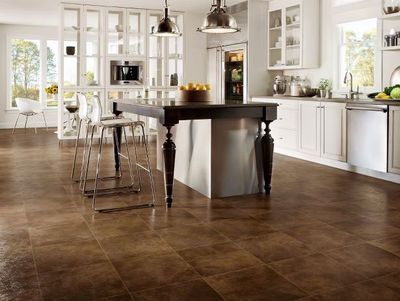Resilient & Luxury Vinyl Flooring
At
Sam’s Flooring, we are happy to offer everything from base grade vinyl to the latest and greatest in
luxury vinyl
options. Ascension and Adura are two classifications in the luxury vinyl category that have taken off very well. These products, made to look like ceramic or wood, are luxury vinyl that can be installed floating or glued down. They can also be staggered, and with realistic knots and scraping, it looks just like a heavy duty wood floor. Resilient floors are capable of installation over many existing surfaces and are also easy to clean and resist stains better than most other floors. Simply sweep and damp mop from time to time to keep them looking new. Whether you want stone looking vinyl, tile looking vinyl, wood looking vinyl, or any of the hundreds of choices we offer, Sam’s Flooring is happy to help with any of your needs!
Our Installation Process
There are two ways to install. The way we prefer is the glued down over a 1/4 inch luan with pressure-sensitive adhesive. Then we install the product of your choosing. We choose this method because if you damage a piece of your flooring, you can heat that piece, pull it up, and put another piece down in its place.
Premium Glueless LVT flooring is installed as a floating floor so it’s quick and easy to install with no adhesive required. All you need is a smooth dry surface and a few basic hand tools. Once the floor is installed it can receive traffic immediately.
Recommended Use
- Residential and light commercial applications
- Interior use in enclosed, climate controlled areas
- Do not install over ramps
General Information
- Always store and transport cartons stacked neatly on a smooth, flat, solid surface
- Do not stack more than 10 cartons high.
- Acclimate flooring and room at a constant temperature between 65F and 85F for 24 hours prior to, during and 24 hours after installation. Thereafter maintain temperatures between 65F and 85F.
- Always allow a ¼” expansion space around the entire perimeter of the room and at all fixtures and pipes. Cover the exposed edges with trim or fill the gap with a high quality silicone caulking.
- Note: All base cabinets and islands must be installed prior to installing flooring (floating floors only).
brands we carry
Click on the links below to learn more!
Ascension - Only Collections Available are Passage and Outland
Hilltop, Eastern Resilient, Mohawk, Adura, Triversa, Chesapeake, Next Floors
Sheet Vinyl



